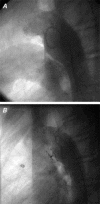Percutaneous closure of window-type patent ductus arteriosus: using the CardioSEAL and STARFlex devices
- PMID: 12959211
- PMCID: PMC197326
Percutaneous closure of window-type patent ductus arteriosus: using the CardioSEAL and STARFlex devices
Abstract
Transcatheter closure of patent ductus arteriosus is routinely performed using various devices. After the withdrawal of the Rashkind umbrella device from the market, the wide window-type patent ductus arteriosus has been difficult to close percutaneously. Two patients with this condition are presented: a 17-year-old man and a 62-year-old woman with short (4.5- and 5.2-mm-diameter, respectively) ductus. We successfully implanted a 17-mm CardioSEAL device in the 1st patient and a 23-mm STARFlex in the 2nd, with no residual shunt at follow-up (22 and 8 months, respectively). Although these devices (which follow the general design of the Rashkind umbrella) are usually applied to atrial septal defect closure, we believe that CardioSEAL and STARFlex implants could be the treatment of choice in percutaneous treatment.of window-type patent ductus arteriosus.
Figures


References
-
- Gersony WM, Apfel HD. Patent ductus arteriosus and other aortopulmonary anomalies. In: Moller JH, Hoffman JI, editors. Pediatric cardiovascular medicine. New York: Churchill Livingstone; 2000. p. 323–34.
-
- Hung J, Landzberg MJ, Jenkins KJ, King ME, Lock JE, Palacios JF, Lang P. Closure of patent foramen ovale for parodoxical emboli: intermediate-term risk of recurrent neurological events following transcatheter device placement. J Am Coll Cardiol 2000;35:1311–6. - PubMed
-
- Krichenko A, Benson LN, Burrows P, Moes CA, McLaughin P, Freedom RM. Angiographic classification of the isolated, persistently patent ductus arteriosus and implications for percutaneous catheter occlusion. Am J Cardiol 1989;63:877–80. - PubMed
-
- Cambier PA, Kirby WC, Worham DC, Moore JW. Percutaneous closure of the small (less than 2.5 mm) patent ductus arteriosus using coil embolization. Am J Cardiol 1992;69:815–6. - PubMed
Publication types
MeSH terms
LinkOut - more resources
Full Text Sources
